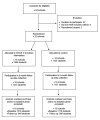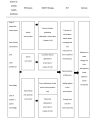A Multicomponent mHealth-Based Intervention (SWAP IT) to Decrease the Consumption of Discretionary Foods Packed in School Lunchboxes: Type I Effectiveness-Implementation Hybrid Cluster Randomized Controlled Trial
- PMID: 34185013
- PMCID: PMC8277365
- DOI: 10.2196/25256
A Multicomponent mHealth-Based Intervention (SWAP IT) to Decrease the Consumption of Discretionary Foods Packed in School Lunchboxes: Type I Effectiveness-Implementation Hybrid Cluster Randomized Controlled Trial
Abstract
Background: There is significant opportunity to improve the nutritional quality of foods packed in children's school lunchboxes. Interventions that are effective and scalable targeting the school and home environment are therefore warranted.
Objective: This study aimed to assess the effectiveness of a multicomponent, mobile health-based intervention, SWAP IT, in reducing the energy contribution of discretionary (ie, less healthy) foods and drinks packed for children to consume at school.
Methods: A type I effectiveness-implementation hybrid cluster randomized controlled trial was conducted in 32 primary schools located across 3 local health districts in New South Wales, Australia, to compare the effects of a 6-month intervention targeting foods packed in children's lunchboxes with those of a usual care control. Primary schools were eligible if they were not participating in other nutrition studies and used the required school communication app. The Behaviour Change Wheel was used to co-design the multicomponent SWAP IT intervention, which consisted of the following: school lunchbox nutrition guidelines, curriculum lessons, information pushed to parents digitally via an existing school communication app, and additional parent resources to address common barriers to packing healthy lunchboxes. The primary outcome, mean energy (kilojoules) content of discretionary lunchbox foods and drinks packed in lunchboxes, was measured via observation using a validated school food checklist at baseline (May 2019) and at 6-month follow-up (October 2019). Additional secondary outcomes included mean lunchbox energy from discretionary foods consumed, mean total lunchbox energy packed and consumed, mean energy content of core lunchbox foods packed and consumed, and percentage of lunchbox energy from discretionary and core foods, all of which were also measured via observation using a validated school food checklist. Measures of school engagement, consumption of discretionary foods outside of school hours, and lunchbox cost were also collected at baseline and at 6-month follow-up. Data were analyzed via hierarchical linear regression models, with controlling for clustering, socioeconomic status, and remoteness.
Results: A total of 3022 (3022/7212, 41.90%) students consented to participate in the evaluation (mean age 7.8 years; 1487/3022, 49.22% girls). There were significant reductions between the intervention and control groups in the primary trial outcome, mean energy (kilojoules) content of discretionary foods packed in lunchboxes (-117.26 kJ; 95% CI -195.59 to -39.83; P=.003). Relative to the control, the intervention also significantly reduced secondary outcomes regarding the mean total lunchbox energy (kilojoules) packed (-88.38 kJ; 95% CI -172.84 to -3.92; P=.04) and consumed (-117.17 kJ; 95% CI -233.72 to -0.62; P=.05). There was no significant difference between groups in measures of student engagement, consumption of discretionary foods outside of school hours, or cost of foods packed in children's lunchboxes.
Conclusions: The SWAP IT intervention was effective in reducing the energy content of foods packed for and consumed by primary school-aged children at school. Dissemination of the SWAP IT program at a population level has the potential to influence a significant proportion of primary school-aged children, impacting weight status and associated health care costs.
Trial registration: Australian Clinical Trials Registry ACTRN12618001731280; https://www.anzctr.org.au/Trial/Registration/TrialReview.aspx?id=376191&isReview=true.
International registered report identifier (irrid): RR2-10.1186/s12889-019-7725-x.
Keywords: child nutrition; childhood obesity; children; hybrid; lunchboxes; mHealth; randomized controlled trial; schools; technology.
©Rachel Sutherland, Alison Brown, Nicole Nathan, Serene Yoong, Lisa Janssen, Amelia Chooi, Nayerra Hudson, John Wiggers, Nicola Kerr, Nicole Evans, Karen Gillham, Christopher Oldmeadow, Andrew Searles, Penny Reeves, Marc Davies, Kathryn Reilly, Brad Cohen, Luke Wolfenden. Originally published in the Journal of Medical Internet Research (https://www.jmir.org), 24.06.2021.
Conflict of interest statement
Conflicts of Interest: Authors RS, NN, LW, KG, NE, and JW receive salary support from their respective local health districts. Hunter New England Local Health District contributes funding to the project outlined in this protocol. None of these agencies were involved in the peer review of this grant. RS and NN are associate editors for BMC Public Health. All other authors declare that they have no competing interests.
Figures
Similar articles
-
Protocol for an effectiveness- implementation hybrid trial to assess the effectiveness and cost-effectiveness of an m-health intervention to decrease the consumption of discretionary foods packed in school lunchboxes: the 'SWAP IT' trial.BMC Public Health. 2019 Nov 12;19(1):1510. doi: 10.1186/s12889-019-7725-x. BMC Public Health. 2019. PMID: 31718597 Free PMC article. Clinical Trial.
-
A randomized controlled trial to assess the potential efficacy, feasibility and acceptability of an m-health intervention targeting parents of school aged children to improve the nutritional quality of foods packed in the lunchbox 'SWAP IT'.Int J Behav Nutr Phys Act. 2019 Jul 2;16(1):54. doi: 10.1186/s12966-019-0812-7. Int J Behav Nutr Phys Act. 2019. PMID: 31266506 Free PMC article. Clinical Trial.
-
Cluster randomised controlled trial of an m-health intervention in centre-based childcare services to reduce the packing of discretionary foods in children's lunchboxes: study protocol for the 'SWAP IT Childcare' trial.BMJ Open. 2019 Jun 1;9(5):e026829. doi: 10.1136/bmjopen-2018-026829. BMJ Open. 2019. PMID: 31154306 Free PMC article.
-
School lunchboxes as an opportunity for health and environmental considerations: a scoping review.Health Promot Int. 2023 Feb 1;38(1):daac201. doi: 10.1093/heapro/daac201. Health Promot Int. 2023. PMID: 36715703 Free PMC article.
-
The effectiveness of lunchbox interventions on improving the foods and beverages packed and consumed by children at centre-based care or school: a systematic review and meta-analysis.Int J Behav Nutr Phys Act. 2019 Apr 29;16(1):38. doi: 10.1186/s12966-019-0798-1. Int J Behav Nutr Phys Act. 2019. PMID: 31036038 Free PMC article.
Cited by
-
SmilesUp text message intervention for early childhood dental caries prevention: A protocol for a randomised controlled trial.PLoS One. 2024 Sep 30;19(9):e0310561. doi: 10.1371/journal.pone.0310561. eCollection 2024. PLoS One. 2024. PMID: 39348422 Free PMC article.
-
Reduction in intake of discretionary foods and drinks among Danish schoolchildren: dietary results from the real-life cluster-randomised controlled trial 'Are You Too Sweet?'.Public Health Nutr. 2024 Mar 26;27(1):e111. doi: 10.1017/S1368980024000740. Public Health Nutr. 2024. PMID: 38528814 Free PMC article. Clinical Trial.
-
A Descriptive Qualitative Study of the Perceptions of Regulatory Authorities, Parents, and School Canteen Owners in the South of Ecuador about the Challenges and Facilities Related to Compliance with the National Regulation for School Canteens.Int J Environ Res Public Health. 2023 Mar 29;20(7):5313. doi: 10.3390/ijerph20075313. Int J Environ Res Public Health. 2023. PMID: 37047929 Free PMC article.
-
Disseminating health research to public health policy-makers and practitioners: a survey of source, message content and delivery modality preferences.Health Res Policy Syst. 2023 Nov 27;21(1):121. doi: 10.1186/s12961-023-01066-7. Health Res Policy Syst. 2023. PMID: 38012773 Free PMC article.
-
Characterisation of At-Scale Community Health Interventions Aimed to Improve Healthy Eating Behaviour in Australia: A Rapid Review.Health Promot J Austr. 2025 Jul;36(3):e70061. doi: 10.1002/hpja.70061. Health Promot J Austr. 2025. PMID: 40566934 Free PMC article. Review.
References
-
- Report of the Commission on Ending Childhood Obesity: implementation plan: executive summary. World Health Organization. 2017. [2021-05-01]. https://www.who.int/end-childhood-obesity/publications/echo-plan-executi...
-
- Venn AJ, Thomson RJ, Schmidt MD, Cleland VJ, Curry BA, Gennat HC, Dwyer T. Overweight and obesity from childhood to adulthood: a follow-up of participants in the 1985 Australian Schools Health and Fitness Survey. Med J Aust. 2007 May 07;186(9):458–60. doi: 10.5694/j.1326-5377.2007.tb00997.x. - DOI - PubMed
-
- School policy framework: implementation of the WHO global strategy on diet, physical activity and health. World Health Organization. 2008. [2021-05-01]. https://apps.who.int/iris/handle/10665/43923.
Publication types
MeSH terms
LinkOut - more resources
Full Text Sources
Medical
Miscellaneous



